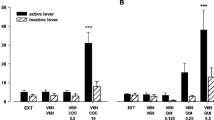Summary
-
1.
Low-affinity (micromolar)3H-dopamine binding was measured under conditions which permitted dopamine activation and opiate inhibition of adenylate cyclase in rat striatal membranes. Opiate drugs and peptides inhibited the dopamine binding in the presence of both GTP5 and Gpp(NH)p. Opiate inhibition of adenylate cyclase was, however, observed only in the presence of GTP.
-
2.
It is suggested that the dopamine D1 receptor in striatum may be modulated by the opiate delta receptor through a shared guanine nucleotide binding subunit.
Similar content being viewed by others
Abbreviations
- Gpp(NH)p:
-
guanosine-5′-(β-imido)triphosphate
- EGTA:
-
ethylene glycol bis(β-aminoethyl ether)
- IBMX:
-
isobutyl methylaxanthine
- GTP:
-
guanosine 5′-triphosphate
References
Biggio, G., Casu, M., Corda, M. G., Dibello, C., and Gessa, G. L. (1978). Stimulation of dopamine synthesis in caudate nucleus by intrastriatal enkephalins and antagonism by naloxone.Science 200552–554.
Blume, A. J., Lichtschein, D., and Boone, G. (1979). Coupling of opiate receptors to adenylate cyclase: Requirement for Na+ and GTP.Proc. Natl. Acad. Sci. USA 765626–5630.
Bowen, W. D., Gentleman, S., Herkenham, M., and Pert, C. B. (1981). Interconverting mu and delta forms of Type 1 opiate receptors in rat striatal patches.Proc. Natl. Acad. Sci. USA 784818–4822.
Bradford, M. M. (1976). A rapid and sensitive method for the quantitation of microgram quantities of protein utilizing the principle of protein-dye binding.Anal. Biochem. 72248–254.
Cassel, D., Eckstein, F., Lowe, M., and Selinger, Z. (1979). Determination of the turn-off reaction for the hormone-activated adenylate cyclase.J. Biol. Chem. 2549835–9838.
Chang, K.- J., Hazum, E., Killian, A., and Cuatrecasas, P. (1981). Interactions of ligands with morphine and enkephalin receptors are differentially affected by guanine nucleotide.Mol. Pharmacol. 201–7.
Collier, H. O. J., and Roy, A. C. (1974). Morphine-like drugs inhibit the stimulation by E prostaglandins of cyclic AMP formation by rat brain homogenate.Nature 24824–27.
Cooper, D. M. F., Schlegel, W., Lin, M. C., and Rodbell, M. (1979). The fat cell adenylate cyclase system: Characterization and manipulation of its bimodal regulation by GTP.J. Biol. Chem. 2548927–8931.
Cooper, D. M. F., Londos, C., Gill, D. L., and Rodbell, M. (1982). Opiate receptor-mediated inhibition of adenylate cyclase in rat striatal plasma membranes.J. Neurochem. 381164–1167.
Creese, I., Usdin, T., and Snyder, S. H. (1979). Guanine nucleotides distinguish between two dopamine receptors.Nature 278577–578.
Dunlap, C. E., Leslie, F. M., Rado, M., and Cox, B. M. (1979). Ascorbate destruction of opiate stereospecific binding in guinea pig brain homogenate.Mol. Pharmacol. 16105–119.
Gentleman, S., Parenti, M., Commissiong, J. W., and Neff, N. H. (1981). Dopamine-activated adenylate cyclase of spinal cord: Supersensitivity following transection of the cord.Brain Res. 210271–275.
Gilman, A. J. (1970). A protein binding assay for adenosine 3′:5′-cyclic monophosphate.Proc. Natl. Acad. Sci. USA 67305–312.
Kayaalp, S. O., Rubenstein, J. S., and Neff, N. H. (1981). Inhibition of D-1 and D-2 binding sites in neuronal tissue by ascorbate.Neuropharmacology 20409–410.
Kimura, N., and Nagata, N. (1977). The requirement of guanine nucleotides for glucagon stimulation of adenylate cyclase in rat liver plasma membranes.J. Biol. Chem. 2523829–3835.
Koski, G., and Klee, W. A. (1981). Opiates inhibit adenylate cyclase by stimulating GTP hydrolysis.Proc. Natl. Acad. Sci. USA 784185–4189.
Koski, G., Simonds, W. F., and Klee, W. A. (1981). Guanine nucleotides inhibit binding of agonists and antagonists to soluble opiate receptors.J. Biol. Chem. 2561536–1538.
Lal, H. (1975). Minireview: Narcotic dependence, narcotic action and dopamine receptors.Life Sci. 17483–396.
Law, P. Y., Wu, J., Koehler, J. E., and Loh, H. H. (1981). Demonstration and characterization of opiate inhibition of the striatal adenylate cyclase.J. Neurochem. 361834–1846.
Nemeroff, C. B. (1980). Neurotensin: Perchance an endogenous neuroleptic.Biol. Psychiat. 15283–302.
Nishikori, K., Noshiro, O., Sano, K., and Maeno, H. (1980). Characterization, solubilization and separation of two distinct dopamine receptors in canine caudate nucleus.J. Biol. Chem. 25510909–10915.
Parenti, M., Gentleman, S., Olianas, and Neff, N. H. (1981). The dopamine receptor-adenylate cyclase complex: Evidence for post recognition site involvement for the development of supersensitivity.Neurochem. Res. 7115–124.
Rodbell, M. (1980). The role of hormone receptors and GTP-regulatory proteins in membrane transduction.Nature 28417–22.
Salomon, Y., Londos, C., and Rodbell, M. (1974). A highly sensitive adenylate cyclase assay.Anal. Biochem. 58541–548.
Sharma, S. K., Nirenberg, M., and Klee, W. A. (1975). Morphine receptors as regulators of adenylate cyclase activity.Proc. Natl. Acad. Sci. USA 72590–594.
U'Prichard, D. C., and Snyder, S. H. (1980). Interactions of divalent cations and guanine nucleotides at alpha2-noradrenergic receptor binding sites in bovine brain membranes.J. Neurochem. 34385–394.
Walczak, S. A., Wilkening, D., and Makman, M. H. (1979). Interaction of morphine, etorphine and enkephalins with dopamine-stimulated adenylate cyclase of monkey amygdala.Brain Res. 160105–116.
Watanabe, A. M., McConnaughey, M. M., Strawbridge, R. A., Fleming, J. W., Jones, L. R., and Besch, M. R., Jr. (1978). Muscarinic cholinergic receptor modulation of beta-adrenergic receptor affinity for catecholamines.J. Biol. Chem. 2534833–4836.
Williams, L. T., and Lefkowitz, R. J. (1977). Slowly reversible binding of catecholamine to a nucleotide-sensitive state of the beta-adrenergic receptor.J. Biol. Chem. 2527207–7213.
Author information
Authors and Affiliations
Rights and permissions
About this article
Cite this article
Gentleman, S., Parenti, M., Neff, N.H. et al. Inhibition of dopamine-activated adenylate cyclase and dopamine binding by opiate receptors in rat striatum. Cell Mol Neurobiol 3, 17–26 (1983). https://doi.org/10.1007/BF00734995
Received:
Revised:
Accepted:
Issue Date:
DOI: https://doi.org/10.1007/BF00734995



